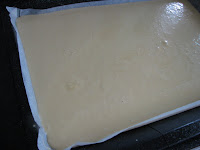"De(s)serted" figs
I've bought already several times fresh figs from Culina. I ate them right away with some slices parma ham and cheese. Initially I always wanted to use them to cook with but never made it. A few days ago I bought some figs again and decided to make a dessert with. Jules at her blog stonesoup features a recipe for an ice cream with fresh figs but she recommended the on with dried. She adapted the recipe from Greg & Lucy Malouf in Saha which doesn't call for custard stirring in a double boiler. She served the ice cream with pistaccios and fresh black figs. I will go for fresh figs stuffed with homemade "walnutsan" baked in kataifi pastry. And I made some slightly changes in the ice recipe. It will be enough for 5 portions.


Ingredients for the ice cream:
135 gdried figs, coursely chopped
110 gbrown sugar
1vanilla bean, preferably Tahitian, halved and seeds scratched out
165 mlwater
4egg yolks (freeze the egg whites for future use for baiser meringues/pavlovas , soufflés , maccarons , marshmellows , tuiles)
400 mlwhippening/heavy cream
200 mlsour cream
Preparation:
Combine figs, sugar, vanilla bean and water in a small saucepan and stir over a low heat until sugar is dissolved. Bring to the boil and simmer for 15 minutes, stirring occassionaly. Discards the vanilla bean.
Place figs with the syrup in a food processor and whizz until smooth.
Combine whippening cream and sour cream and stir until smooth.
Whisk yolks over a hot water bath in a double boiler until fluffy and they start to thicken.
Add the cream mixture, and the fig purée and whisk for about 10 minutes over medium-high heat. (You can reduce the mixture further to a custard-pudding and eat it right away or sprinkle some brown sugar over it and burn the surface with a blow torch for a crème brûlée.)
Cool on an ice bath. Refrigerate until well chilled, about ½ an hour.
Churn in an icecream machine according to the manufacturer’s instructions. Freeze until frozen.

Ingredients for the fig parcels:
30 gwalnuts, ground to a fine powder
30 gicing/confectioners' sugar
afew drops elderberry syrup, cranberry syrup or balsamic syrup I left some fo the fig syrup(strained) from the ice cream
5fresh figs
5filo pastry, thawed under a damp teatowel
4 Tbspunsalted butter, melted
1 tspcaster sugar
Preparation:
Preheat the oven to 150°C.
Place the walnuts together with the sugar in a blender. Combine thoroughly and add the syrup. Let blend until it forms a smooth paste.
Wash the figs and score their top third with an X. Divide the walnut-paste in 5 equal portions and form balls with it. Fill the figs with the paste.
Cut 5 20-cm-quarters out from an aluminium foil.
Cut the each filo sheets in fine strips onto one aluminium foil-quarter. Sprinkle with melted butter and sugar, place one stuffed fig on it. By pulling the aluminium foil up around the figs and pinching the ends together at the top, cover the figs with the kataifi pastry. Place the parcels on a baking sheet. Bake in the preheated oven for 15 minutes. Open the aluminium foil and bake for further 20 minutes.

As a sauce and a colour-source I blended
5strawberries together with
1 Tbspremained fig-syrup from the ice cream, and
½ tspcaster sugar. I reduced the thin juice over low heat for about 2 minutes.
And made another sauce with
3 Tbspblanched and powdered pistaccios and mixed them with
1 Tbspwhipped cream, and
½ tspcaster sugar.

I still have 5 figs, and I've already some ideas what tho make with. Let's see....










































